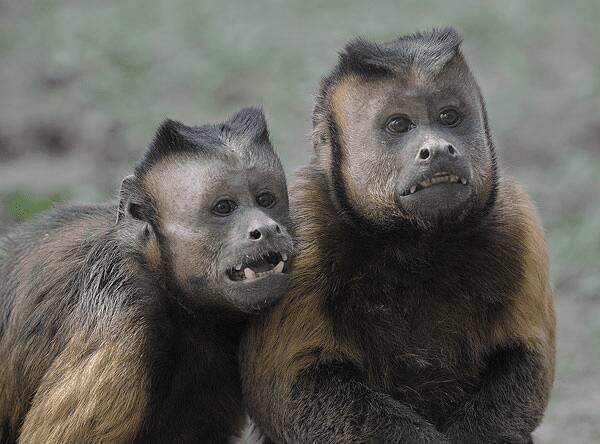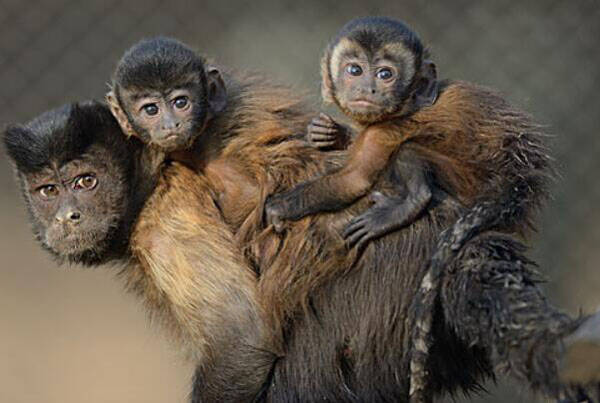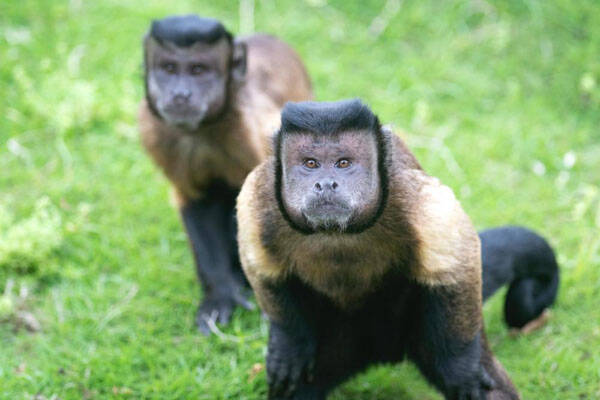Sapajus apella
IUCN
LCBasic Information
Scientific classification
- name:Sapajus apella
- Scientific Name:Sapajus apella,Black-capped Capuchin、 Guianan Brown Capuchin、 Margarita Island Capuchin、 Tufted Capuchin, Apella、 Faunaffe、Gehaubter Kapuziner
- Outline:Primates
- Family:C.m.family
Vital signs
- length:35-49cm
- Weight:2.3-4.8kg
- lifetime:30-45years
Feature
The Internet celebrity monkey with a square face
Distribution and Habitat
It inhabits nearly all types of Amazonian lowland and submontane forests. This includes moist subtropical or tropical forests, but is also found in dry forests, gallery forests, disturbed forests, and secondary forests. In northwestern Argentina, the black-capped monkey lives in montane forests at elevations of 200-1100 m. The species prefers the forest understory and canopy, but often comes down from the trees to forage for food and play. The black-capped monkey has the widest distribution range and the widest habitat tolerance of any other species in its genus.
Appearance
The black-capped sifaka is a relatively large species, weighing 2.3-4.8 kg. The head and body are 35-49 cm long, and the dangling tail is 38-49 cm long. The fur varies in color, ranging from light brown, mustard yellow to black. The fur on the shoulders and lower abdomen is lighter in color than the rest of the body. There is a tuft of coarse black fur on the top of the head, sometimes called a cap, which provides the species with a common name, the black-capped sifaka or tufted sifaka. The facial pattern of the species varies from individual to individual, but the black sideburns extending from the top of the head are characteristic of the black-capped sifaka. The color of the limbs and tail varies from dark brown to black, with the tail being the darkest part of the body. The tail of this species is long and tightly coiled for easy grasping. This species is powerfully built with large jaw muscles to adapt to feeding on large fruits, nuts, and coarse vegetation. Males are 34% larger i
Details
Black-capped Capuchin (scientific name: Sapajus apella) is called Black-capped Capuchin, Guianan Brown Capuchin, Margarita Island Capuchin, Tufted Capuchin in English, Apella, Faunaffe, Gehaubter Kapuziner in German, and has 2 subspecies.

Black-capped monkeys typically have a home range of 25-40 hectares, but can range up to 355 hectares at 2,000 meters per day. Home ranges may overlap by 40%, and different groups have been observed foraging near each other without confrontation.
Black-capped monkeys are social animals, and small groups of 8-15 black-capped monkeys form small groups. Juvenile males leave the group when they reach sexual maturity and look for new mating groups. Therefore, the core members of a group are females who usually spend their entire lives in the same group. The group is led by a dominant male, who most actively protects the group from predators and other monkey groups. If another group enters their home range, the dominant male will lead the members to attack and drive the other group away. However, black-capped monkeys are less aggressive towards other groups than other species of the same genus. The dominant male has the first choice in mating and food sources. When food is scarce and a new source is found, the dominant male always eats first. Other members of the group that are favored by the dominant male can eat with him, but subordinate members must wait until the priority group has finished eating. This priority group usually consists of adolescents, infant monkeys, and a few favorite females. While dominant males are generally tolerant of their offspring, the offspring of formerly dominant males are met with great hostility. Most aggression that occurs within a group stems from competition for food.
Black-capped shrike are diurnal, arboreal animals. Most travel is accomplished by quadrupedal hopping and climbing. Mutual grooming is common throughout the group. They mark their scent by washing their hands with their own urine and rubbing them on their fur. This may be a way for males to announce their sexual maturity. Females in estrus attempt to attract the attention of dominant males by calling loudly. Black-capped shrike have a variety of vocalizations, which are divided into 4 types: connecting the group, connecting individuals, ending aggressive encounters, and alerting the group to the presence of danger. Gestures and facial expressions are also widely used for communication, and social grooming is an important form of contact.
Black-capped shrike are very wary of predators. Dominant males protect their flock from predators by making alarm calls. A flock member will make a shrill call when he sees an eagle. The species is so wary of eagles that they will make alarm calls even if the bird flying overhead is harmless. The call can summon its flock to escape danger in time.

The foraging behavior of black-capped monkeys is a noisy and destructive activity. They move from tree to tree, cracking nuts on branches. They hunt and capture whatever is inside by breaking and tearing the outer skin, including searching for vertebrates and invertebrates. Individuals that capture prey usually do not share with other group members. The black-capped monkey is an omnivore, with fruit making up a large part of its diet, and due to its strong jaws, the black-capped monkey can eat larger fruits than other monkeys. Food includes fruit, seeds, nectar, insects, crustaceans, reptiles, insects, birds and small mammals (such as mice and opossums). During the dry season, when food is scarce, palm leaves are essential for the survival of this animal.
The black-capped monkey is an important predator of small animals, and it may disperse some seeds of forest plants while eating fruit. The species can often be seen mixed with other species, most commonly with monkeys of the genus Saimiri sp. It is usually the squirrel monkeys who initiate the mixed group interaction, probably to find food more efficiently. The squirrel monkeys follow the black-capped monkeys to find new food sources, thus saving time for them to forage on their own. This interactive association does not seem to benefit the black-capped monkey, but rather the squirrel monkeys.
The black-capped monkey is a widespread species in the lower Amazon. The species is found in Bolivia, Brazil, Colombia, Ecuador, French Guiana, Guyana, Peru, Suriname, and Venezuela.

The black-capped monkey has a polygynous mating system. Females mate preferentially with dominant males. When dominant males are absent, other males have the opportunity to mate. During the last two days of the female's estrous cycle, dominant males are very protective and prevent females from mating with subordinate males. Reproduction occurs year-round, but most babies are born during the dry season or early rainy season. The ovulation period lasts about 21 days, and the female's external genitalia swell during estrus. The gestation period is 150-160 days, with one baby born per litter, and twins are very rare. Parenting is exclusive to females, and although males are tolerant of sub-adults, they do not participate in raising them. Allomaternalization is a common practice. Young black-capped monkeys cling to their mother's fur for the first few months of life. During this time, females carry the babies around and feed them. If a young black-capped monkey is separated from its mother, other members of the group will respond to the baby's distress calls. Young males leave their natal group once they reach sexual maturity. Male black-capped monkeys reach sexual maturity at 7 years of age. Females reach sexual maturity earlier and may be able to reproduce as early as 4 years of age. Typical lifespan in the wild is unknown, but captive black-capped monkeys may live to 45 years of age.
The population density of the Margarita Island subspecies of black-capped monkeys has not yet been properly determined. The results of ongoing work on the ecology and conservation projects of this subspecies will determine the density of this subspecies in the near future. In 1994, according to the surveys conducted by Sanz and Marquez, the total population of the Margarita Island subspecies was only 250-300 animals. Marquez and Sanz (1991) estimated that 0.02-0.23 groups/hour were observed in different forest fragments. The average group size was 4.5 individuals. In the surveys conducted in 2007, the group size varied between 2-15 individuals.
In Tinigua National Park, Stevenson et al. recorded a density of 16 black-capped monkeys per square kilometer in 1992, and in 2007 Stevenson estimated the density to be 27 per square kilometer. In 1975 and 1977, the species density in Manu National Park was estimated to be 36 per square kilometer, and in 1983 and 1985, a similar density of 40 per square kilometer was found.

The black-capped monkey is small in size, has a wide range of food, is stable in character, is smart, easy to train, and has a playful and cute appearance, so it often appears in movies, mainly in the Americas. For example, a black-capped monkey appeared once in Jim Carrey's comedy film "Bruce Almighty", where it was manipulated by the protagonist and got into the street gangsters' house... There is also a black-faced black-capped monkey in the fantasy comedy "Night at the Museum", and it is an important character. In addition, black-capped monkeys also appear in the classic movie "Pirates of the Caribbean" series, and there are more than one kind. In addition, black-capped monkeys have appeared in many well-known movies such as "Garfield (Live-Action)", "The Hangover", "I Bought a Zoo", "Zoo Keeper", and "Doctor Dolittle".
Listed in the "IUCN Red List of Endangered Species" (IUCN) 2020 ver3.1-Least Concern (LC).
Listed in Appendix I, Appendix II and Appendix III of the Convention on International Trade in Endangered Species of Wild Fauna and Flora (CITES) 2019 Edition Appendix II.
Protect wild animals and stop eating game.
Maintaining ecological balance is everyone's responsibility!








